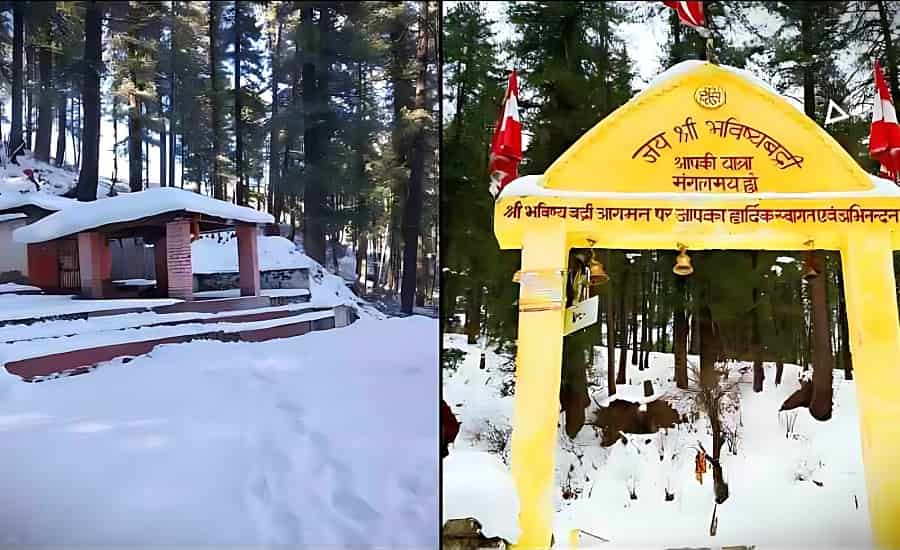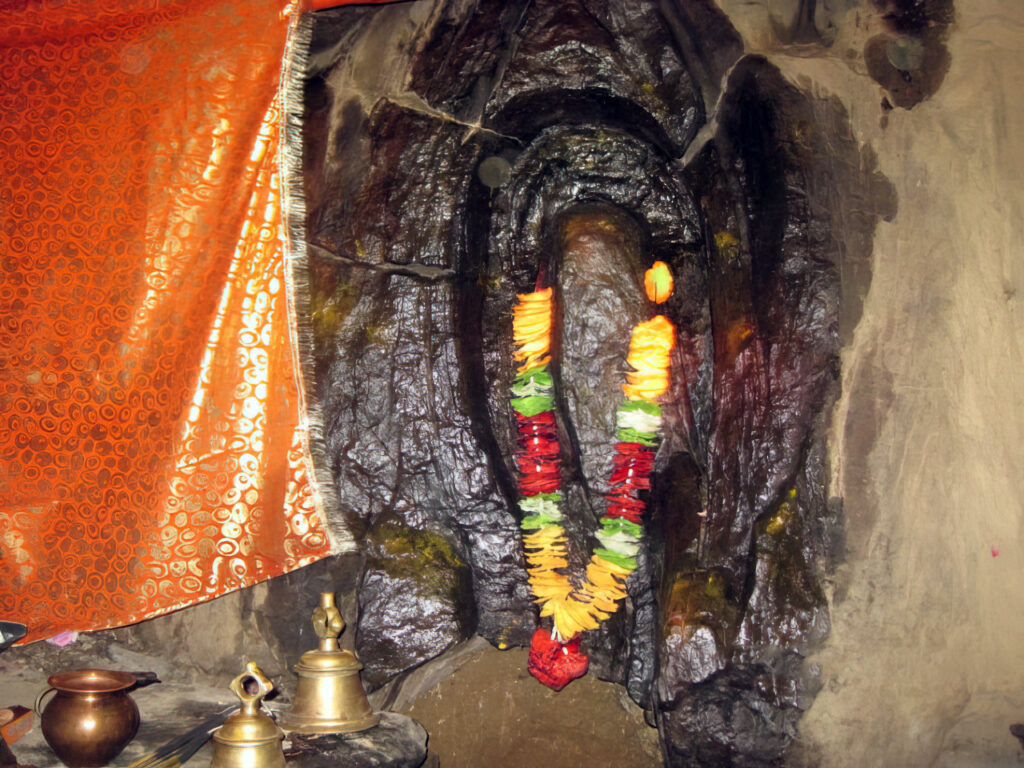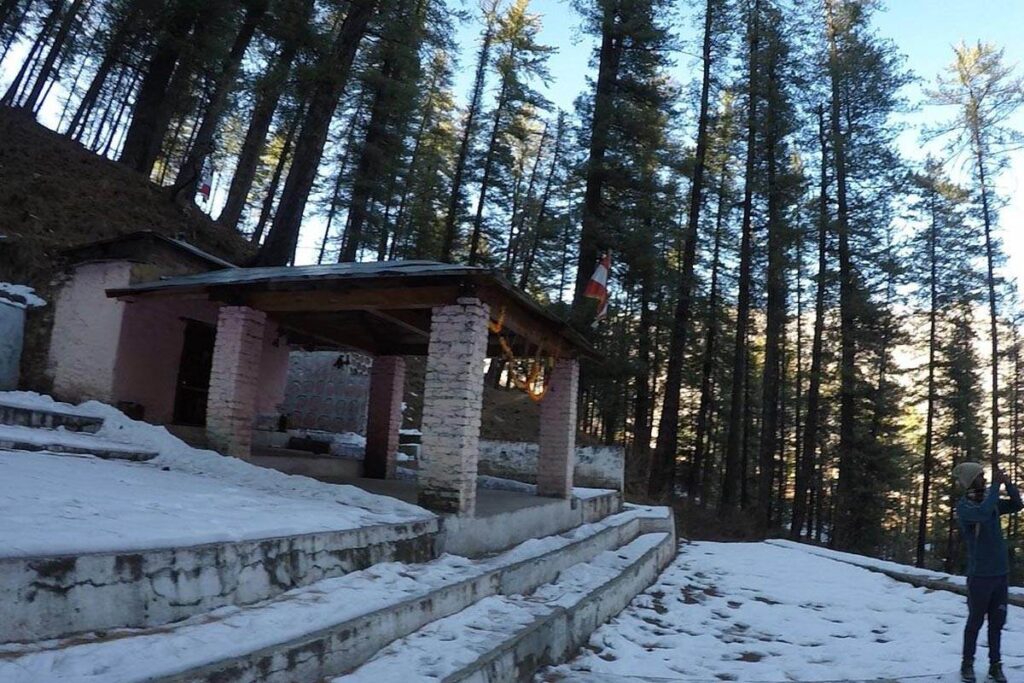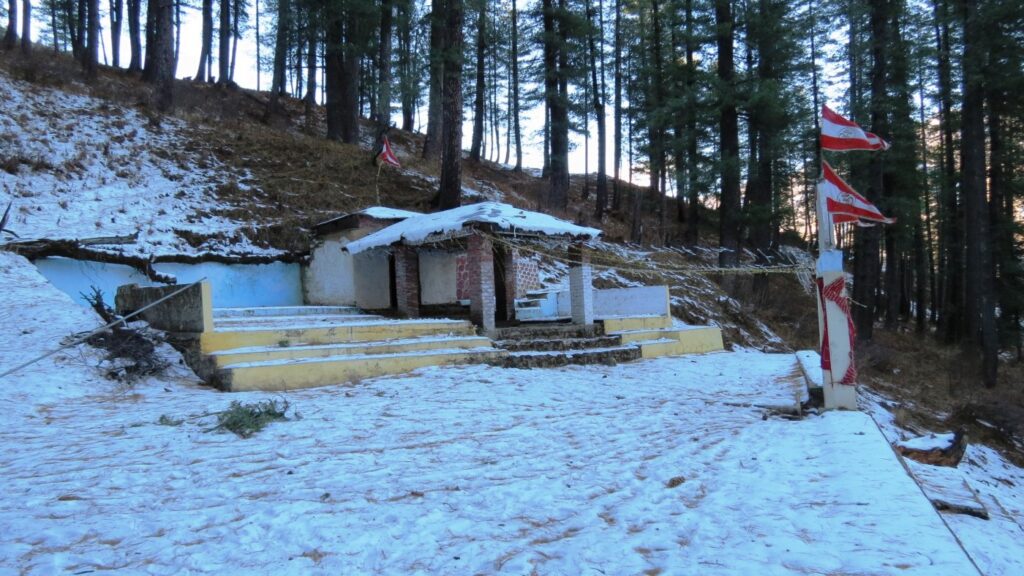Nestled in the pristine valleys of Uttarakhand, Bhavishya Badri is a unique spiritual destination that captures the imagination of both pilgrims and nature lovers. Unlike its more famous siblings in the Char Dham circuit, Bhavishya Badri remains tranquil and relatively untouched, offering a deeply personal connection to the divine. Known as the “Future Badri,” it carries stories of prophecy, devotion, and the serene beauty of the Himalayas.
This hidden gem is part of the Panch Badri circuit and holds immense significance in Hindu mythology. It is believed to be a place where Lord Vishnu will manifest in the future, safeguarding devotees when times grow difficult. The temple’s mystical aura and peaceful surroundings make it a must-visit destination for travelers seeking spirituality, adventure, and solitude.

The Mythological Significance of Bhavishya Badri
Bhavishya Badri, meaning the “Badri of the Future,” is unique among the Badri temples. While Badrinath is the well-known present abode of Lord Vishnu, Bhavishya Badri represents the future incarnation and protection of the deity.
Prophecy and Divine Protection
The mythology of Bhavishya Badri is intertwined with the concept of dharma—the moral and cosmic law that maintains balance in the universe. Devotees believe that in an era when evil dominates, and the world faces chaos, Lord Vishnu will appear here to guide humanity back toward righteousness.
Local legends tell of ancient sages and rishis who foresaw the need for a future abode of Vishnu. Sage Narada, known for his travels across the universe spreading divine wisdom, is said to have visited the site and declared that the future generations would rely on this temple for spiritual guidance. Similarly, Sage Vyasa, the author of the Mahabharata, is believed to have prophesied the temple’s significance, linking it to the preservation of dharma in times yet to come.
This prophetic aspect is what makes Bhavishya Badri not just a place of worship but a symbol of hope and divine continuity. For pilgrims, visiting the temple is a reminder that even in turbulent times, the divine presence is ever-watchful and protective.

Connection to Badrinath
Bhavishya Badri shares an intrinsic link with Badrinath, the present-day northern seat of Lord Vishnu. While Badrinath represents the current manifestation and ongoing protection of the deity, Bhavishya Badri represents the future. This duality symbolizes the timelessness of divine guidance.
- Badrinath as the present – The site is associated with worship, pilgrimage, and ongoing spiritual practices.
- Bhavishya Badri as the future – It embodies the continuity of divine intervention during periods of moral and social upheaval.
This connection underscores a profound spiritual message: the divine is not bound by time. The presence of Vishnu transcends generations, and Bhavishya Badri ensures that even when earthly conditions become challenging, there is a sacred refuge for devotees.

Legends Surrounding Bhavishya Badri
Several legends add depth to the mythology of Bhavishya Badri, making it an enigmatic yet deeply revered site.
1. The Sage and the Vision
One popular legend tells of a wandering sage who experienced a vision of Lord Vishnu in the Himalayas. Vishnu appeared and explained that during future times of darkness, this location would become a sanctuary for devotees. The sage, awed by the divine promise, consecrated the site, ensuring that future generations would have a place to connect with the Lord.
2. The Protective Aspect
According to folklore, Bhavishya Badri will serve as a protective stronghold where Lord Vishnu’s energy will manifest to guide humanity. Unlike other temples that are celebrated for miracles or historical significance, Bhavishya Badri’s mythology emphasizes cosmic responsibility and divine intervention.
3. Connection with Local Deities
The region surrounding Bhavishya Badri is home to smaller shrines dedicated to local deities and river spirits. Mythology suggests that these deities serve as guardians, maintaining the sanctity of the temple until the predicted time when Vishnu’s manifestation will occur. This interweaving of local and pan-Hindu belief systems creates a unique spiritual ecosystem.

Symbolism in Mythology
Bhavishya Badri’s mythology is rich in symbolism, conveying profound spiritual truths through its narratives:
- Future as Hope – The very idea of a temple for the future reminds devotees that hope persists even during turbulent times.
- Divine Continuity – Lord Vishnu’s presence across time illustrates that spiritual guidance is eternal.
- Sanctuary in Isolation – Located deep in the Himalayas, the temple represents a retreat where devotees can find clarity and peace, untouched by worldly distractions.
- Integration of Nature and Spirituality – The surrounding forests, rivers, and mountains are not just scenic; they are considered extensions of the temple’s sanctity, reinforcing the interconnectedness of nature and divinity.
Pilgrimage and Spiritual Practices
Mythology has also influenced the way pilgrims engage with Bhavishya Badri. Visiting the temple is considered an act of faith and preparation for spiritual challenges. Devotees often perform the following practices inspired by legend:
- Meditation and Reflection – Pilgrims meditate in the quiet surroundings, seeking guidance and peace.
- Offering Simple Prayers – Unlike grand rituals, simplicity is emphasized, reflecting the timeless nature of the divine.
- Journey as Devotion – The trek to the temple itself symbolizes the path of righteousness—challenging but rewarding.
The mythology thus shapes not only the significance of the temple but also the behavior and mindset of those who visit it.

Bhavishya Badri in Local Culture
Local communities have preserved the myths surrounding Bhavishya Badri for generations. Stories of sages, divine visions, and future protection are passed down orally, keeping the spiritual heritage alive. Festivals, though modest, celebrate the timeless nature of Vishnu’s presence, linking mythology with contemporary devotion.
The local folklore reinforces the message that Bhavishya Badri is a temple not just of the past, but of the future, bridging generations through faith and storytelling.
Modern Relevance of the Mythology
Even today, the mythology of Bhavishya Badri resonates with devotees and seekers:
- It reminds us that spiritual guidance transcends time.
- It offers a place of refuge in the mind, symbolically preparing humans to face challenges with faith.
- It encourages sustainable pilgrimage, as the temple’s remoteness emphasizes harmony with nature.
For scholars and spiritual seekers, Bhavishya Badri represents an intersection of mythology, prophecy, and human experience—a reminder that devotion and divine presence are constants, regardless of worldly circumstances.s give the temple a mystical aura, making it a site of faith not only for pilgrims but also for those fascinated by spiritual prophecy.
Location and Accessibility
Bhavishya Badri is located in Chamoli district of Uttarakhand, surrounded by thick forests, rivers, and Himalayan peaks. Its remote location adds to its charm, as the journey itself becomes a pilgrimage.
How to Reach Bhavishya Badri
- By Road – The nearest major towns are Joshimath and Karnaprayag. From these towns, local transport or hired taxis can take you closer to the base of the trek.
- By Rail – Rishikesh is the nearest railway station, connected to major cities like Delhi, Haridwar, and Dehradun. From Rishikesh, travelers can hire taxis or buses to reach the temple’s base.
- By Air – The nearest airport is Jolly Grant Airport in Dehradun, approximately 270 km away. From the airport, travelers can hire cabs or board buses to the foothills.
The journey requires a combination of road travel and trekking, making it suitable for pilgrims who enjoy adventure alongside devotion.
Trekking to Bhavishya Badri
One of the most appealing aspects of visiting Bhavishya Badri is the trek. The temple is located at an altitude of approximately 3,300 meters, and the trail winds through dense forests, mountain streams, and traditional Himalayan villages.
Highlights of the Trek
- Scenic Beauty – Pine and oak forests, cascading waterfalls, and panoramic Himalayan views make the trek visually stunning.
- Wildlife Encounters – The trail passes through areas inhabited by Himalayan birds, deer, and sometimes elusive Himalayan bears.
- Cultural Experience – Local villagers often offer simple meals, guidance, and stories of the temple, giving pilgrims an authentic Himalayan experience.
The trek is moderately challenging, taking around 5 to 6 hours from the base camp depending on the traveler’s pace. For many, the journey itself is as spiritually rewarding as the temple visit.
The Temple Structure
Bhavishya Badri may not be as large or architecturally grand as Badrinath, but it has its own unique charm. The temple is small, made of stone and wood, blending harmoniously with the natural surroundings.
Key Features
- Idol of Lord Vishnu – The main deity is Lord Vishnu in a meditative posture, symbolizing calmness and protection.
- Wooden Carvings – Intricate carvings depict scenes from the Puranas, adding a layer of mythological richness.
- Natural Surroundings – The temple courtyard opens to a view of the Himalayan peaks, rivers, and valleys, making it an open-air meditation space.
The simplicity of the temple allows devotees to focus on spiritual connection rather than grandeur, making it an ideal place for introspection.
Pilgrimage and Rituals
Despite its remote location, Bhavishya Badri has a dedicated following of devotees. Daily rituals are performed by priests who stay in nearby villages, and special ceremonies occur during major festivals.
Important Rituals
- Morning Aarti – Devotees gather for the morning aarti, accompanied by bells and conch shells.
- Offerings – Simple offerings such as rice, fruits, and flowers are made to Lord Vishnu.
- Seasonal Festivals – Festivals like Janmashtami and Diwali are celebrated with small-scale rituals and local participation.
Since the temple is less commercialized, rituals maintain their authenticity, offering a deeply spiritual experience.
Nearby Attractions
Visiting Bhavishya Badri is not just about exploring a single sacred site; it opens the door to a rich tapestry of natural beauty, cultural heritage, and spiritual experiences in the surrounding Himalayan region. Nestled in Uttarakhand’s Chamoli district, the temple’s remote location offers an immersive journey into pristine valleys, flowing rivers, traditional villages, and lesser-known shrines. For pilgrims and travelers alike, exploring these nearby attractions enhances the spiritual and adventurous essence of the Bhavishya Badri trip.
1. Alaknanda River
One of the first highlights near Bhavishya Badri is the Alaknanda River, a sacred tributary of the Ganga. Flowing gracefully through the valleys, it provides a serene backdrop to the temple and nearby trekking routes.
What Makes Alaknanda Special
- Spiritual Significance – Pilgrims often take a ritual dip in the river, believing it purifies the mind and soul before reaching the temple.
- Natural Beauty – Surrounded by snow-capped peaks and dense forests, the river’s flowing waters create picturesque landscapes ideal for meditation and photography.
- Adventure Activities – For adventure seekers, the river offers opportunities for light trekking along its banks and exploring small waterfalls and rapids.
Spending time at Alaknanda allows travelers to connect with the spiritual energy of the region while enjoying the calming presence of the water and mountains.
2. Vishnu Prayag
Another nearby attraction is Vishnu Prayag, one of the sacred confluences of rivers in the Himalayas. Here, the Alaknanda meets the Dhauliganga, creating a confluence considered highly auspicious in Hindu tradition.
Highlights of Vishnu Prayag
- Religious Importance – The confluence is associated with legends of Lord Vishnu and is considered a powerful site for prayers and offerings.
- Scenic Views – The meeting point of the rivers, framed by towering Himalayan peaks, provides breathtaking views, especially during sunrise and sunset.
- Photography Opportunities – The natural beauty, combined with the religious atmosphere, makes it a favorite spot for photographers and travelers alike.
Visiting Vishnu Prayag after Bhavishya Badri creates a sense of continuity, blending spiritual exploration with the serene beauty of Himalayan rivers.
3. Local Himalayan Villages
Bhavishya Badri is surrounded by traditional Himalayan villages that offer an authentic glimpse into mountain life. These villages have preserved their culture, architecture, and customs for generations.
What You Can Experience
- Traditional Architecture – Stone and wooden houses with intricate carvings showcase the region’s craftsmanship.
- Local Cuisine – Simple yet flavorful dishes like steamed rice, lentils, and local Himalayan vegetables give travelers a taste of authentic mountain food.
- Warm Hospitality – Villagers are known for their welcoming nature, often sharing stories of the temple and surrounding landscapes.
- Cultural Immersion – Pilgrims can witness local festivals, rituals, and traditional music performances, which add depth to the spiritual journey.
Spending time in these villages not only supports local communities but also enriches the pilgrimage experience with cultural learning and human connection.
4. Trekking Trails and Nature Walks
The region around Bhavishya Badri is dotted with trekking trails that range from moderate to challenging, providing a perfect blend of adventure and spirituality.
Popular Trails
- Bhavishya Badri to Satopanth Lake – A trek to this high-altitude lake offers panoramic views of the surrounding peaks and is considered spiritually significant.
- Forest Trails – Pine and oak forests along the route create an immersive experience with the sounds of birds and flowing streams.
- Waterfall Treks – Small waterfalls along the trails provide refreshing stops for pilgrims and photographers.
These treks are not just physical challenges; they are symbolic journeys, reflecting the path of devotion and patience that pilgrims experience while approaching the temple.
5. Nearby Lesser-Known Shrines
Apart from Bhavishya Badri itself, the area is home to several smaller shrines that carry local legends and spiritual significance.
- Village Shrines – Many villages have small shrines dedicated to local deities, believed to protect the region and guide pilgrims to Bhavishya Badri.
- Forest Temples – Hidden within forests are ancient temples where sages and hermits are said to have meditated, adding to the mystical aura of the region.
- Riverside Shrines – Shrines along the Alaknanda and Dhauliganga rivers offer tranquil spots for prayer and reflection.
Exploring these shrines allows visitors to connect with the lesser-known spiritual heritage of the region, making the journey to Bhavishya Badri even more enriching.
6. Scenic Viewpoints
For nature enthusiasts, several viewpoints near Bhavishya Badri provide uninterrupted Himalayan vistas.
Recommended Viewpoints
- Mountain Peaks – From certain trails, pilgrims can see snow-clad peaks that seem to touch the sky, creating a sense of awe and humility.
- Valley Overlooks – These spots allow visitors to view the lush valleys carved by rivers, highlighting the region’s natural beauty.
- Sunrise and Sunset Points – Early morning and evening visits to these points offer magical light conditions perfect for photography and meditation.
These scenic spots complement the spiritual energy of Bhavishya Badri, offering quiet moments of reflection and connection with nature.
7. Wildlife and Flora
The forests around Bhavishya Badri are home to diverse flora and fauna, adding to the appeal for eco-conscious travelers.
- Bird Watching – Himalayan birds, including pheasants and colorful migratory species, can be spotted along the trekking trails.
- Flora – The forests boast pine, oak, rhododendron, and medicinal herbs used by local communities for traditional healing.
- Wildlife – While sightings are rare, Himalayan deer, monkeys, and other small mammals inhabit the area, creating a sense of wilderness and adventure.
For travelers who enjoy nature and ecology, these surroundings provide an unforgettable experience alongside spiritual exploration.
8. Adventure Activities
Although Bhavishya Badri is primarily a pilgrimage site, the surrounding region offers adventure opportunities for those seeking physical challenges.
- Trekking and Hiking – Trails vary in difficulty, providing options for both casual trekkers and experienced hikers.
- River Exploration – Sections of the Alaknanda and Dhauliganga rivers are ideal for light trekking and photography.
- Camping – Overnight stays in tents near the river or forest provide an immersive Himalayan experience.
Adventure activities complement the pilgrimage by allowing visitors to experience nature’s raw beauty while cultivating patience, focus, and endurance.ishya Badri not just a spiritual destination but also a nature lover’s paradise.
Tips for Pilgrims and Travelers
Visiting Bhavishya Badri requires preparation due to its remote location and moderate trekking challenges.
- Travel Light – Carry only essentials like water, snacks, and warm clothing.
- Acclimatize – Spend a day at the base camp to adjust to the altitude.
- Hire Local Guides – Local guides enhance the experience with stories, safety tips, and directions.
- Respect Local Customs – Dress modestly, follow temple rules, and maintain cleanliness.
- Carry First Aid – Basic medical supplies are important for trekking in remote areas.
Spiritual Significance Today
Bhavishya Badri may not be as crowded as Badrinath or Kedarnath, but this adds to its charm. The temple symbolizes hope, protection, and the eternal presence of the divine in the future times. Many devotees visit to meditate, seek blessings, or find peace away from the bustle of popular pilgrimage sites.
The serenity of the location, combined with its prophetic significance, makes it a place where devotion, nature, and spiritual reflection converge.
FAQs for Bhavishya Badri
- Where is Bhavishya Badri located?
Bhavishya Badri is situated in the Chamoli district of Uttarakhand, India, amidst the Garhwal Himalayas. - Why is Bhavishya Badri important?
It is one of the five Badri temples and is believed to be visited by Lord Vishnu during future times, giving it its name “Bhavishya” (future). - How to reach Bhavishya Badri?
Reachable via road from Joshimath or via trekking trails from nearby villages; the route is scenic and less crowded. - What is the best time to visit Bhavishya Badri?
April to June and September to October, when weather is pleasant and snow-free. - Are there any special festivals celebrated here?
The temple celebrates major Hindu festivals like Badri-Kedar Utsav and Janmashtami with local rituals. - Is trekking required to reach Bhavishya Badri?
Yes, a short trek from the nearby roadhead is required; it’s moderate and suitable for most pilgrims. - Are accommodations available near Bhavishya Badri?
Basic guesthouses and lodges are available in nearby villages like Subhain and Joshimath. - Can Bhavishya Badri be visited year-round?
No, winters bring heavy snow and landslides, making access difficult; summer and autumn are best. - What is unique about Bhavishya Badri?
It is believed that in the future, the main Badri idol will be shifted here, according to legends in the Skanda Purana. - Is Bhavishya Badri part of the Panch Badri circuit?
Yes, it is one of the five Badri temples: Adi Badri, Bhavishya Badri, Yogadhri Badri, Vriddha Badri, and Nilkanth Badri.


